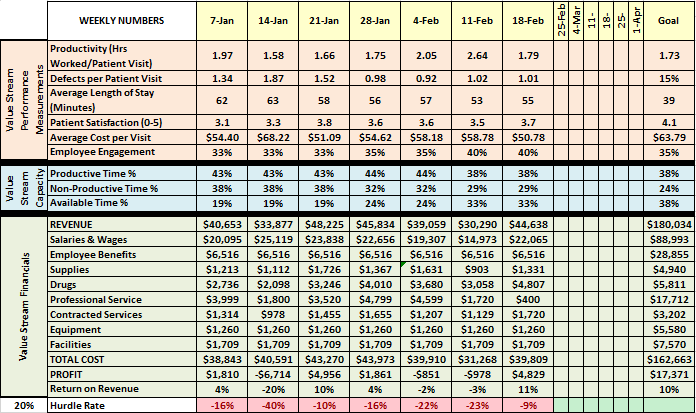Why It Matters
To be true champions of quality and patient safety, clinical leaders can’t afford to be uninformed about the financial side of health care. As margins get tighter for many organizations, system executives need to reduce expenses. If frontline clinical leaders are unable to demonstrate value over time and encourage thoughtful decision making, clinical care may face reactive reductions that cut corners or even harm patients. Clinical leaders need fluency with financial management — not just clinical know-how — to make sure quality and safety are always the top priorities.
Short of getting an MBA, what’s a clinical manager to do?
Tools to Understand Clinical and Financial Data
Frontline leaders need ways to bring together clinical and financial data so they can confidently address financial value in addition to clinical quality. Lean Accounting provides one solution to this challenge. (Lean Accounting refers broadly to applications of Lean thinking principles to accounting and financial functions.) Services like orthopedics and cardiovascular care may find Lean Accounting tools especially useful, but diverse clinical areas can also reap their benefits.
The Box Score is one component of Lean Accounting. It is a set of measures that fits on one sheet of paper that encompasses three performance domains:
- Quality measures — including areas like safety and defects
- Capacity measures — compares overall staff time availability to actual productive use staff time
- Financial measures — addresses major cost items (e.g., supplies) and traditional measures of profitability. For example, the Box Score includes the “hurdle rate,” which is the minimum rate of profitability deemed acceptable.
The Box Score helps frontline managers understand the weekly performance of their clinical service. This could include hip or knee replacement, heart surgery, or cataract surgery service lines. Thus far, IHI has developed Box Scores with a focus on inpatient care; ideally, a manager in a health system could develop a Box Score that links together multiple sites of care.
Supporting Frontline Managers
The Box Score serves as the anchor for continuous value management. (Continuous value management is a set of methods that can help achieve standardization, increase efficiency, and optimize resources to increase the value of their services.) It informs frontline managers so they can solve problems before they jeopardize the core of their business. Reviewing quality, capacity and financial measures on a weekly basis, can help the frontline manager identify areas of variation, triggering further drill-downs and ultimately strategic decisions.
The Metrics That Matter Most
Clinical and operational leaders must work together to select the right measure set for the Box Score. Every clinical service will have a different Box Score, and Box Scores will vary across health systems. The measures selected should flow directly from the strategic plan of the department or service line, which in turn should align with the strategy of the broader organization.
Leaders should conduct a “mapping exercise,” listing strategic goals and possible measures. Then, based on the availability of data, the relative importance of the measures brainstormed, and the consensus of the participants, the team selects a smaller set of measures.
The mapping exercise is valuable since it helps you define how to work toward strategic goals on a weekly basis.

Example of a Box Score - Performance measures include clinical quality. Capacity measures allow for continuous tracking of staff utilization. Income statement measures are segmented by level of impact.
Populating the Box Score
Every facility has access to different information for the Box Score. For example, some facilities have advanced clinical analytics systems that reduce lag in measure calculation. Others have to pull data routinely from an assortment of different financial, human resources, and quality data systems, such as registries and routinely collected accounting data. Regular and accurate weekly Box Score updates require new workflows and communication between clinical and financial staff. Units with embedded financial analysts may find such updates easier, but this type of organizational structure is not necessary.
Managers can also use the Box Score to compare different improvement project ideas, estimating the impact on multiple dimensions of the clinical service. For example, health care providers can use the Box Score as a structure to understand the impact of new investments in staff, or changes in the way supplies are purchased. Given limited resources for improvement, the Box Score can help managers make better choices about which projects to pursue.
Toward Financial Literacy for Clinical Managers
Lean Accounting tools can play a powerful role for clinical leaders, not just financial staff. Whether evaluating current performance or estimating the impact of projects or decisions, the Box Score forces managers to simultaneously examine financial, clinical, and efficiency measures, increasing the odds of more effective action and better value over time for patients and the organization.
Jeffrey Rakover is an IHI Research Associate and a member of the IHI Innovation Team.
Photo by Michael C | Unsplash
